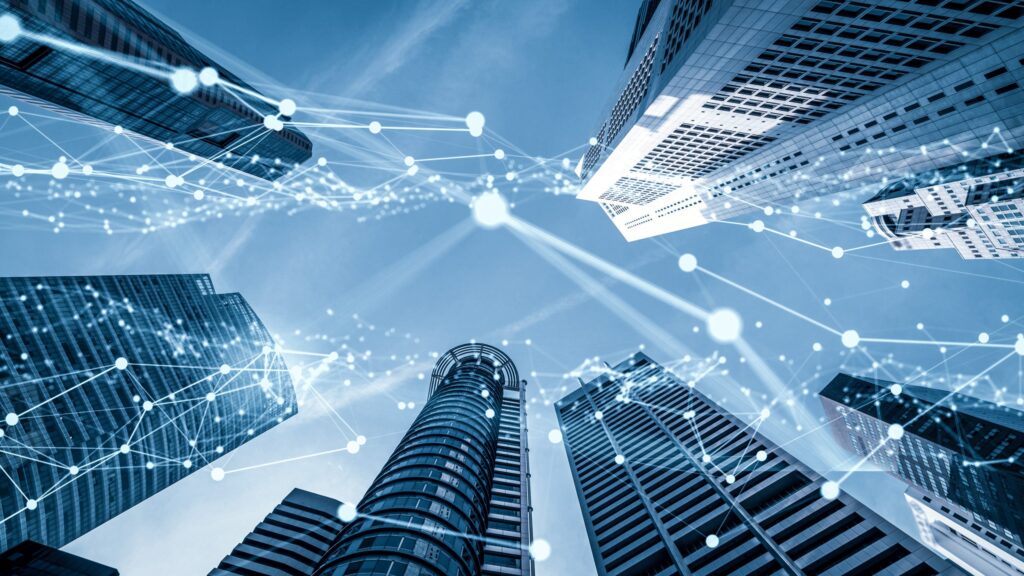Technology Building refers to the process of creating, developing, and implementing technological solutions. This involves research, design, and continuous innovation.
Technology Building is crucial for modern advancements. It spans various fields like software development, hardware engineering, and data science. This process often starts with identifying a problem or need. Solutions are then designed, tested, and optimized. Innovation is key, driving continuous improvements and adaptations.
Teams of experts collaborate, bringing diverse skills to the table. Successful technology building leads to products and services that enhance everyday life. Companies invest heavily in research and development. This ensures they stay competitive and meet evolving market demands. The ever-evolving landscape of technology requires constant learning and adaptation. Technology Building is the backbone of modern innovation.

Introduction To Technology Building: Advancing Architectural Innovations”
Technology Building explores architectural innovations, blending cutting-edge tech with design. This field pushes boundaries, creating efficient and sustainable structures.
Emerging technologies are revolutionizing the architectural world. From smart buildings to sustainable designs, innovations are reshaping how structures are conceptualized, built, and operated. This transformation is not only enhancing aesthetics but also functionality and efficiency.
Smart Building Technologies
Smart buildings are a game-changer in modern architecture. These structures utilize advanced systems to optimize energy use, security, and comfort.
- Intelligent HVAC systems: Regulate temperature and air quality.
- Automated lighting: Adjusts based on occupancy and natural light.
- Energy management systems: Monitor and reduce energy consumption.
- Security systems: Integrate with smart surveillance and access control.
Sustainable Architectural Practices
Sustainability is at the forefront of architectural innovation. Eco-friendly designs and materials are becoming the norm.
Green buildings utilize renewable resources and sustainable materials. These practices reduce carbon footprints and promote environmental health. The following points exemplify these sustainable efforts:
- Solar panels: Generate clean energy.
- Green roofs: Provide insulation and manage stormwater.
- Recycled materials: Minimize waste and resource depletion.
- Water-efficient systems: Conserve water through smart usage.
Advanced Construction Methods
Revolutionary construction methods are being adopted worldwide. These techniques enhance durability, reduce costs, and accelerate project timelines.
- 3D printing: Creates complex structures efficiently.
- Prefabrication: Assembles building components off-site.
- Modular construction: Enables faster and scalable building processes.
- Robotics: Automates repetitive construction tasks.
Integration Of Iot In Buildings
The Internet of Things (IoT) is transforming how buildings operate. IoT devices provide real-time data and control systems remotely.
- Smart sensors: Monitor environmental conditions.
- Connected appliances: Improve energy efficiency.
- Predictive maintenance: Identifies issues before they escalate.
- Occupant tracking: Enhances space utilization and safety.
Virtual And Augmented Reality In Design
Virtual and augmented reality (VR/AR) are powerful tools in architectural design. They offer immersive experiences and precise visualizations.
- VR walkthroughs: Allow clients to explore designs.
- AR overlays: Provide real-time modifications.
- 3D modeling: Enhances design accuracy and creativity.
- Collaboration tools: Facilitate remote teamwork.
Building Information Modeling (bim)
Building Information Modeling (BIM) is crucial in modern architecture. BIM integrates data and processes for seamless project execution.
BIM enhances collaboration and efficiency. It offers comprehensive insights into the building lifecycle. Key aspects of BIM include:
- Design coordination: Ensures all stakeholders are aligned.
- Construction simulation: Identifies potential issues early.
- Asset management: Streamlines maintenance and operation.
- Data centralization: Provides a single source of truth for all project data.
Renewable Energy Integration
Integrating renewable energy sources in buildings is a significant trend. It promotes sustainability and reduces reliance on fossil fuels.
- Solar energy: Harnesses sunlight for power.
- Wind turbines: Capture wind energy for electricity.
- Geothermal systems: Utilize the earth’s heat for temperature control.
- Energy storage: Ensures a steady power supply from renewable sources.
Adaptive Reuse Of Buildings
Adaptive reuse is a sustainable approach to architecture. It involves repurposing existing structures for new uses.
Repurposing buildings preserves history and reduces waste. It also provides unique and innovative spaces. Examples of adaptive reuse include:
- Converting warehouses: Transforming into loft apartments.
- Renovating old factories: Becoming trendy office spaces.
- Repurposing churches: Turning into community centers.
- Updating historic homes: Modernizing for contemporary living.
Smart City Integration
Smart cities integrate various technologies to improve urban living. These cities focus on sustainability, efficiency, and quality of life.
- Smart grids: Manage energy distribution efficiently.
- Public transportation: Optimized through real-time data.
- Waste management: Improved through automated systems.
- Urban planning: Enhanced by data-driven decision-making.
Biophilic Design
Biophilic design connects occupants with nature. It incorporates natural elements into built environments.
- Natural light: Maximizes daylight exposure.
- Indoor plants: Improve air quality and aesthetics.
- Water features: Create calming environments.
- Natural materials: Provide a tactile and visual connection to nature.
These architectural innovations demonstrate the endless possibilities technology brings to the field. Embracing these advancements will lead to more sustainable, efficient, and beautiful buildings.
2. “key Features And Sustainable Practices In Modern Technology Building”
Modern technology buildings integrate energy-efficient systems and smart automation. Sustainable practices include using renewable materials and optimizing natural light.
Modern technology buildings are transforming the landscape of urban development. These structures are not just about aesthetics; they incorporate advanced features and sustainable practices that set them apart. Let’s explore some key elements that define these innovative buildings.
Smart Infrastructure
Modern technology buildings are equipped with smart infrastructure. This includes:
- IoT Sensors: Monitor building conditions and optimize energy usage.
- Automated Systems: Control lighting, heating, and cooling for efficiency.
- Integrated Security: Advanced surveillance and access control systems.
Energy Efficiency
Energy efficiency is a cornerstone of sustainable building design. These buildings often feature:
- Solar Panels: Harness renewable energy from the sun.
- LED Lighting: Reduces energy consumption significantly.
- High-Performance Insulation: Keeps interiors comfortable and reduces heating and cooling needs.
Sustainable Materials
Using sustainable materials is essential for minimizing environmental impact. These materials include:
- Recycled Steel: Offers strength while reducing waste.
- Bamboo Flooring: A renewable resource that’s also stylish.
- Low-VOC Paints: Improve indoor air quality by emitting fewer chemicals.
Green Spaces
Incorporating green spaces in building design enhances both environmental and human health. Features may include:
- Green Roofs: Provide insulation and reduce stormwater runoff.
- Vertical Gardens: Improve air quality and aesthetic appeal.
- Outdoor Courtyards: Offer relaxing spaces for occupants and promote biodiversity.
Water Conservation
Water conservation measures are vital in modern buildings. These practices help reduce water usage:
- Rainwater Harvesting: Collects and stores rainwater for reuse.
- Low-Flow Fixtures: Minimize water wastage without compromising performance.
- Greywater Systems: Recycle water from sinks and showers for landscaping.
Renewable Energy Integration
Renewable energy sources are increasingly integrated into building designs. These sources provide clean energy:
- Wind Turbines: Generate electricity from wind power.
- Geothermal Systems: Use the Earth’s natural heat for heating and cooling.
- Photovoltaic Glass: Converts sunlight into electricity while serving as windows.
Advanced Hvac Systems
Heating, ventilation, and air conditioning systems are crucial for comfort and efficiency. Modern systems include:
- Zoned Heating: Allows precise temperature control in different areas.
- Heat Recovery Ventilation: Recovers and reuses heat from exhaust air.
- Smart Thermostats: Optimize energy use based on occupancy and preferences.
Resilient Design
Resilient design ensures buildings withstand various challenges. Key features include:
- Seismic-Resistant Structures: Built to endure earthquakes.
- Flood Defenses: Protect against water damage.
- Fire-Resistant Materials: Enhance safety and reduce fire risks.
Waste Management
Effective waste management is integral to sustainable building practices. Techniques used are:
- On-site Recycling: Sorts and recycles construction waste.
- Composting Facilities: Convert organic waste into useful compost.
- Waste-to-Energy Systems: Transform waste into renewable energy.
Indoor Environmental Quality
High indoor environmental quality promotes occupant well-being. Elements that contribute include:
- Natural Lighting: Reduces the need for artificial lighting and boosts mood.
- Air Purification Systems: Remove contaminants from indoor air.
- Acoustic Design: Minimizes noise pollution for a better living and working environment.
Incorporating these features and practices ensures that modern technology buildings are not only functional but also sustainable. This approach benefits both the environment and the people who use these buildings.
3. “technological Integration In Building Design And Construction”
Technological integration revolutionizes building design and construction, enhancing efficiency and sustainability. Advanced tools streamline planning and execution, ensuring superior results.
Technological advancements have revolutionized building design and construction. These innovations streamline processes, enhance efficiency, and create sustainable structures.
Smart Building Materials
Smart building materials are transforming construction. These materials offer various benefits:
- Self-healing concrete: Repairs cracks automatically, reducing maintenance costs.
- Phase-change materials: Regulate indoor temperatures, improving energy efficiency.
- Electrochromic glass: Adjusts tint based on sunlight, enhancing comfort and reducing energy consumption.
Building Information Modeling (bim)
BIM is a game-changer in the construction industry. It involves creating digital representations of buildings:
- 3D modeling: Visualizes the entire building, aiding in design and planning.
- Collaboration tools: Allows multiple stakeholders to work on the same model simultaneously.
- Cost estimation: Provides accurate budget forecasts, minimizing financial risks.
Internet Of Things (iot) Integration
IoT integration in building design brings numerous advantages. This technology connects devices and systems:
- Smart sensors: Monitor building conditions, ensuring safety and comfort.
- Automated systems: Control lighting, heating, and cooling, enhancing energy efficiency.
- Predictive maintenance: Identifies potential issues before they become problems, reducing downtime.
Robotics In Construction
Robotics are becoming increasingly common on construction sites. They offer various benefits:
- Bricklaying robots: Increase speed and precision, reducing labor costs.
- Drones: Conduct site surveys and inspections, improving safety and efficiency.
- Autonomous vehicles: Transport materials and equipment, streamlining logistics.
Virtual And Augmented Reality
Virtual and augmented reality are transforming the way buildings are designed and constructed. These technologies offer immersive experiences:
- Design visualization: Allows stakeholders to experience the building before construction begins.
- Training simulations: Provides realistic scenarios for worker training, improving safety and skills.
- On-site support: Augmented reality overlays information on real-world views, aiding in construction tasks.
Sustainable Technologies
Sustainable technologies are crucial in modern building design. They help reduce the environmental impact:
- Solar panels: Generate renewable energy, lowering electricity costs.
- Green roofs: Improve insulation and reduce urban heat island effects.
- Rainwater harvesting: Collects and stores rainwater for reuse, conserving water resources.
4. “success Stories: Impactful Projects In Technology Building”
Explore compelling success stories of impactful projects in technology building. Discover how innovative solutions transform industries and drive progress. Witness the power of cutting-edge technologies in creating tangible results.
Technology Building has rapidly transformed various industries. Let’s explore some remarkable success stories that have made significant impacts.
Smart Cities: Revolutionizing Urban Living
Smart cities have redefined urban living, integrating technology to enhance residents’ quality of life.
- Intelligent traffic management: Reduces congestion and improves commute times.
- Waste management systems: Optimize collection routes, reducing costs and environmental impact.
- Smart lighting: Saves energy by adjusting brightness based on real-time data.
- Public safety: Uses surveillance and analytics for rapid response to incidents.
Green Energy Solutions: Sustainable Future
Green energy projects have made strides in technology building, focusing on sustainability and efficiency.
Renewable energy sources like solar and wind power are leading the charge. These projects harness natural resources to generate power, reducing our carbon footprint and dependency on fossil fuels.
Healthcare Innovations: Saving Lives With Technology
Healthcare has benefited immensely from technological advancements.
- Telemedicine platforms: Allow remote consultations, increasing access to healthcare.
- Wearable health devices: Monitor vital signs, providing real-time data to doctors.
- AI diagnostics: Improve accuracy and speed in identifying medical conditions.
- Robotic surgeries: Enhance precision, reducing recovery times.
Educational Technology: Empowering Learning
Education technology has transformed how students learn and teachers teach.
Interactive digital classrooms have become the norm. They provide immersive learning experiences, making education more engaging and accessible for everyone.
Fintech Breakthroughs: Transforming Financial Services
Fintech innovations have revolutionized the financial industry.
- Mobile banking apps: Offer convenience and accessibility to users.
- Blockchain technology: Ensures secure and transparent transactions.
- AI financial advisors: Provide personalized investment advice.
- Contactless payments: Increase speed and security in transactions.
Advanced Manufacturing: Boosting Production Efficiency
Advanced manufacturing techniques have redefined production processes.
Robotic automation has improved efficiency and precision. It allows factories to produce goods at a faster rate with reduced human error.
Autonomous Vehicles: Redefining Transportation
Autonomous vehicles are changing the way we think about transportation.
- Self-driving cars: Reduce accidents and improve road safety.
- Delivery drones: Speed up logistics and reduce delivery times.
- Autonomous public transit: Increases efficiency and reduces operational costs.
- Smart infrastructure: Supports the integration of autonomous vehicles into daily life.
These success stories highlight the transformative power of technology building across various sectors. The future holds even more promise as we continue to innovate and integrate technology into our daily lives.
5. “future Trends In Technology Building: Enhancing Efficiency And Sustainability
Advancements in technology building are driving efficiency and sustainability in construction. Emerging trends focus on smart materials and green architecture. Sustainable practices and innovative designs help reduce environmental impact.
The rapid evolution of technology building is reshaping our world. Emerging trends are enhancing both efficiency and sustainability. Let’s dive into the future of technology building.
Smart Building Technologies
Smart buildings integrate advanced systems for optimal performance:
- IoT sensors: Monitor and control building systems in real-time.
- AI-driven analytics: Optimize energy usage and maintenance schedules.
- Automated controls: Adjust lighting, heating, and cooling based on occupancy.
Renewable Energy Integration
Buildings are increasingly incorporating renewable energy solutions. This shift is driven by the need for sustainability and cost savings.
Energy Storage Solutions
Energy storage systems are becoming crucial in modern buildings:
- Battery systems: Store excess energy for later use.
- Thermal storage: Capture and reuse heat energy.
- Grid integration: Balance energy demands and supply efficiently.
Sustainable Construction Materials
The choice of materials in construction is evolving. Sustainable materials reduce environmental impact and improve building longevity.
Building Information Modeling (bim)
BIM is revolutionizing construction processes:
- 3D modeling: Visualize and plan building projects accurately.
- Real-time collaboration: Share updates and changes instantly with all stakeholders.
- Enhanced project management: Track progress and identify issues early.

Frequently Asked Questions
What Is Technology In Building?
Technology in building involves using advanced tools, materials, and methods to improve construction efficiency, sustainability, and safety. It includes smart systems, automation, and innovative building materials. This technology enhances project management, reduces costs, and ensures better quality structures.
What Is A Building Technologist?
A building technologist designs and oversees construction projects. They ensure structures are safe, functional, and energy-efficient.
What Is The Difference Between Building And Building Technology?
A building is a structure with walls and a roof. Building technology involves the methods and tools used in construction.
What Is Building Design And Technology?
Building design and technology involve planning, creating, and constructing structures using advanced methods and materials. This field focuses on aesthetics, functionality, sustainability, and innovation to enhance building efficiency and comfort.
Conclusion
Embracing technology in building processes transforms efficiency, sustainability, and innovation. Future advancements promise even more significant benefits. By integrating modern tech, businesses can stay competitive and meet evolving demands. Keep exploring new technologies to push the boundaries of what’s possible in construction.
Stay ahead and build smarter for tomorrow.








